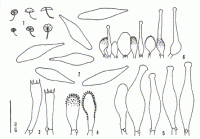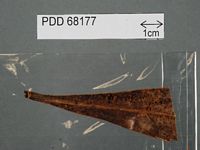|
 Marasmius rhombisporus Marasmius rhombisporus
BiostatusPresent in region - Indigenous. Endemic
Images (click to enlarge)
Caption: Fig. 8 (1-6). Marasmius rhombisporus Desjardin & E. Horak (PDD, holotype).- 1.
Basidiomes.- 2. Basidiospores.- 3. Basidia.- 4. Cheilocystidia a).- 5. Cheilocystidia b).- 6.
Pileipellis. | 
Caption: Dried type specimen
Owner: Herb PDD |
Article: Desjardin, D.E.; Horak, E. (1997). Marasmius and Gloiocephala in the South Pacific Region: Papua New Guinea, New Caledonia, and New Zealand taxa. Bibliotheca Mycologica 168: 152 p.
Description: Pileus 3-7 mm diam, hemispherical to convex, disc not depressed, margin weakly plicate; surface
dull, dry to moist or gelatinous in wet conditions, glabrous to minutely pruinose; evenly pale beige.
Texture membranaceous; context very thin, white.- Lamellae broadly adnate or seldom
subdecurrent, distant (5-8), lamellulae absent, narrow; white to pale beige-brown; edges even,
concolorous.- Stipe 4-10 x 0.3-0.5 mm, central, equal, cylindrical, curved, wiry, tough, minutely
pruinose, insititious, erumpent through leaf epidermis leaving a small cupulate structure around the
base; apex pale brown, fuscous to black elsewhere.- Odor and taste not distinctive.
Basidiospores 12.5-15.5 x 3.0-4.0 µm, fusoid to narrowly rhomboid, smooth, thin-walled, hyaline,
inamyloid.- Basidia 24-30 x 7-8 µm, subclavate, 4-spored, clamped.- Cheilocystidia of 2 types: a)
Rotalis-type cells 20-30 x 7-18 µm, clavate to ovoid, thin-walled or apically slightly thickwalled,
hyaline; divergent setulae 1-2 x 1 µm, cylindrical; b) 30-48 x 6-12 µm, fusoid-capitate, capitulum
up to 6 µm diam, hyaline, thin-walled.- Pleurocystidia absent.- Pileipellis hymeniform, composed of
Rotalis-type cells and pileocystidia; Rotalis-type cells 20-30 x 8-20 µm, clavate to ovoid, thin-walled, apex pale reddish brown, base hyaline; divergent setulae 1-2 x 1.01.5 µm, cylindrical.-
Pileocystidia 35-60 x 7-13 µm, lecythiform with elongate neck and enlarged base, hyaline, thin-walled, capitulum up to 5 µm diam, base smooth or seldom with scattered setulae.- Tissue at stipe
apex dextrinoid.- Cau1ocystidia numerous, like fusoid-capitate cheilocystidia.-Clamp
connections present.
Habitat: Habit, habitat and distribution.- Gregarious in dense groups on rotting leaves of Pseudopanax
crassifblium or P. ferox. New Zealand.
Notes: Marasmius rhombisporus is one of three New Zealand Marasmius with pileipellis composed of
Rotalis-type cells in combination with conspicuous, projecting pileocystidia. These features
indicate placement in sect. Epiphylli subsect. Epiphylloidei Singer, albeit this infrageneric taxon
is hardly distinguishable from some pale pigmented members of sect. Hygrometrici. Features that
characterize M. rhombisporus include a small, pale beige pileus, well-developed, distant lamellae,
large, narrowly rhomboid basidiospores, two types of cheilocystidia, fusoid-capitate caulocystidia,
and growth on leaves of Pseudopanax. Marasmius meridionalis differs in forming smaller white
pilei, a smooth hymenophore, much smaller basidiospores, and basidiome formation on leaves of
Nothofagus. Marasmius rhopalostylidis differs in forming smaller ellipsoid basidiospores, fusoid-ventricose cystidia with a long non-capitate neck (never fusoid-capitate), and basidiome formation
on leaves of Rhopalostylis. The European species, M. epiphylloides (Rea) Sacc. & Trott. is also
similar, but differs in forming white pilei, cylindrical (not rhomboid) basidiospores, only one type of
cheilocystidia, dermatocystidia that are fusoid to lageniform and only obscurely subcapitate (never
capitate as in M. rhombisporus), and basidiome production is restricted to leaves and twigs of
Hedera helix.
|